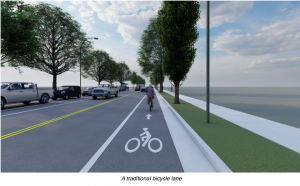 VDOT has recently started releasing educational material and videos on various bicycle and pedestrian treatments. These are great introductions to bicycle and pedestrian infrastructure as well as reminders of the rules of the road for riders and motorists. FABB encourages everyone to share this blog post and the link widely with all of the riders and motorists you know.
VDOT has recently started releasing educational material and videos on various bicycle and pedestrian treatments. These are great introductions to bicycle and pedestrian infrastructure as well as reminders of the rules of the road for riders and motorists. FABB encourages everyone to share this blog post and the link widely with all of the riders and motorists you know.
Here are some highlights from the VDOT website page’s discussion of bicycle lanes:
Description
- Traditional bicycle lanes are one-way facilities running along the curb, shoulder, or on-street parking lane that carry bicycle traffic in the same direction as motor vehicle traffic.
- A traditional bicycle lane is designated by pavement markings and signing for the preferential use of bicycles.
- Traditional bicycle lanes have horizontal separation (i.e. pavement markings, such as solid white lines) but do not have vertical separation between the bike lane and the vehicle travel lane and/or parking lane.
How to Use A Traditional Bicycle Lane
- As they ride, bicyclists should be aware of turning motor vehicles and opening doors. A bicyclist may leave a traditional bicycle lane to pass other users, make turns, or avoid obstacles.
- Drivers may cross through a traditional bicycle lane only to make a right turn or to enter/exit a parking spot. When making a right turn or accessing parking, drivers are required to yield to bike traffic, then merge into the bike lane and turn from the curb or park. In these instances, the bicyclist should pass on the left as the driver merges to the right.
- Drivers may not drive or park in a traditional bicycle lane unless weather conditions, an accident, or another emergency situation requires them to do so.
Context
- A traditional bicycle lane is often installed on streets with moderate average daily traffic, speed limits below 35 mph, and with high transit vehicle volumes. On low speed streets with higher volumes, a traditional bicycle lane is preferred over a wide curb lane.
- On streets with higher traffic volumes, steep grades, high truck traffic, or high parking turnover, treatments that provide greater physical separation should be considered.
Benefits
- Improved Safety: Provides separation from motor vehicles, establishes predictable riding behavior, visually reminds motorists of bicyclists’ presence and right of way
- Improved comfort: Allows bicyclists to travel at their preferred speed
- Traffic compliance: Reduces wrong way riding
- Increased efficiency: Increases capacity of the roadway
Here’ one final interesting bit of information from VDOT: The cost estimate for bike lane is between $85,000 and $320,000 per mile. The low end assumes only thermoplastic lane lines and signage while the high end estimate assumes the addition of a continuous application of green pavement markings in conflict areas.
Find out more here: http://www.virginiadot.org/programs/bikeped/bicycle_and_pedestrian_treatments.asp
